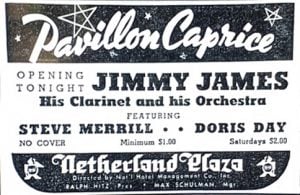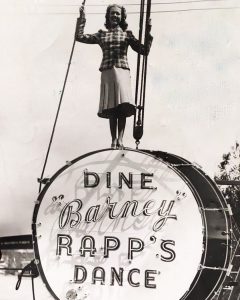By John Schlipp
Special to the NKyTribune
Que será, será
Whatever will be, will be
The future’s not ours to see
Que será, será
What will be, will be
Those are the familiar lyrics of the Academy Award-winning song, “Qué Será, Será (Whatever Will Be, Will Be)”, by Jay Livingston and Ray Evans. It will be forever associated with the voice of one of Cincinnati’s most famous entertainers, Doris Day.

A midwife delivered Doris Kappelhoff at the family’s home at 3475 Greenlawn Avenue, Cincinnati, OH. (Photo by John Schlipp, 2019.)
Her official website obituary stated her significance very succinctly: “Doris Day, Hollywood legend and the only woman to hit No. 1 at the box office and No. 1 on the music charts simultaneously, died May 13, at her Carmel Valley, Calf., home. She was 97.”
As a child growing up in the 1960s, I watched a lot of television. It was a magical window to the world outside of our region. We viewed faraway places and people via the many programs. One such example was the Doris Day Show sitcom, which premièred in 1968 on CBS. One can imagine how the opening credits to Day’s theme song and the backdrop of San Francisco, with its Golden Gate Bridge and cable cars climbing up steep hills (similar to the hills in Cincinnati), appealed to me as an eight-year-old living in a typical Ohio suburb.
Similarly, Doris Day grew up in Cincinnati, with its iconic Roebling suspension bridge and its inclines. In her authorized, candid memoir dating from 1975 (written by A.E. Hotchner), she said, “I could have happily lived my entire life in Cincinnati, married to a proper Cincinnatian, living in a big old Victorian house, raising a brood of offspring, but preordination … had other plans for me.”
Cincinnati’s renowned vocalist was born Doris Mary Anne von Kappelhoff on April 3, 1922, at 3475 Greenlawn Avenue in the Evanston neighborhood, near the campus of Xavier University.

St. Mark’s Catholic Church, in the Evanston neighborhood of Cincinnati, where Doris Day’s father served as organist. (Photo by John Schlipp, 2019. )
Both of her parents were of German heritage. Her father, Frederick Wilhelm von Kappelhoff, was a quiet man who loved classical music. He taught piano and violin students, led multiple choirs as a director, and served as the church organist at St. Mark’s Catholic Church in Evanston. Her mother, Alma Sophia Welz, was a lively and high-spirited woman who enjoyed country and western music.
Her mother’s family owned various bakeries, including a pretzel factory in Cincinnati. Doris’ Uncle Charlie owned Welz Tavern in Price Hill where Doris later lived with her mother in an upstairs apartment.
Perhaps it was her mother’s prompting that initially led Doris to dancing. However, an unfortunate automobile accident with a train led to a severe leg injury that dashed Doris’ dreams of dancing professionally.
Despite her luminous and beaming personality, Doris Day’s life story took many tragic turns. Her parents’ marriage dissolved when she was around eight years old. The divorce meant multiple childhood moves in Cincinnati, from Evanston to College Hill to Price Hill. Sadly, both of Doris’ brothers passed away far too young. And Doris’ only child, Terry, died from melanoma in 2004. Additionally, Doris herself experienced three divorces.

Doris Day performed for a short time with the Jimmy James Orchestra at the Netherland Plaza in Cincinnati. Provided.
Finally, the death of Doris’ third husband, Marty Melcher, left her in considerable debt. Marty and the couple’s attorney had made poor investments choices. Doris had no choice but to star in a television series. Unknown to her, Marty had obligated Doris to a contract for what would become the Doris Day Show on CBS. The sitcom became a surprise hit, and fortuitously, provided financial security in her later years.
While watching the Doris Day series in the 1960s, my parents proudly noted that Doris was originally known as Doris Kappelhoff and sang on WLW radio in Cincinnati. Doris’ voice coach, Grace Raine, had the connections that opened the door to WLW. Doris sang on WLW in the 1940s, including on the programs Moon River (not to be confused with the later movie theme by Henry Mancini and Johnny Mercer from the 1961 film Breakfast at Tiffany’s), and Carlin’s Carnival, where she sang the song “Day After Day,” a melody that ultimately influenced her new stage name.
These early WLW radio sessions teamed her with other staff singers such as the Williams Brothers, including a teenage Andy Williams. As related in an April 13, 2017 story in the Cincinnati Enquirer by Jeff Suess, Doris fondly remembered her work with young Andy Williams: “every Monday night I would go to the Williamses’ and his mother would fix hot chocolate and bake cookies and we’d have a songfest.” Day continued, “Those Monday nights were part of what I enjoyed about life in Cincinnati.”

Doris Day sang at Barney Rapp’s Nightclub, “The Sign of the Drum,” on Reading Road near Bond Hill in Cincinnati. (Source: #doriskappelhoff at the pic deer.)
Cincinnatians loved to sing. Songfests were common in German Cincinnati, where they were called by their German name, “Saengerfests.” German singing societies, or Gesangverein, abounded. They were social clubs that maintained a connection with the German musical and cultural traditions.
In her memoir, Doris Day recounted that her father William Kappelhoff was among Cincinnati’s most-sought-after conductors for singing societies. At one point, he was the director of three societies including the Bakers Singing Society, the Goodfellow Singing Society, and the Clifton Heights Society. Doris said that she remembered, “once going to watch him conduct a choral group that was singing with the Cincinnati Symphony. He got incredible performance out of these amateur groups.”
The vocal career of Doris flourished when local bandleader Barney Rapp needed a lead singer because his wife Ruby Wright (later a regular cast member of Ruth Lyon’s 50-50 Club) left the band to raise their family. At age 16, Doris sang at Rapp’s nightclub called “The Sign of the Drum,” on Reading Road near Bond Hill. Doris adopted the stage name “Day” upon Rapp’s recommendation. He thought the last name “Kappelhoff” was too long for a marquee. Her popular performance of the tune “Day After Day” also influenced the decision. Doris later performed briefly with clarinetist Jimmy James and his Orchestra at the Netherland Plaza’s Pavillon Caprice.

Les Brown and Doris Day in New York City, 1946. (Courtesy of Wikimedia Commons.)
Besides her timeless theme song “Qué Será, Será (Whatever Will Be, Will Be),” Doris Day’s World War II era song, “Sentimental Journey” from 1945, became a classic. This touching tune was performed and recorded with Les Brown and his Band of Renown. Doris spent more time with the Brown band than any others, including a brief stint with Bob Crosby’s band. Brown’s group was a well-groomed band and a good professional fit for Doris. In her memoir, she recalled that Les helped her recording techniques in many ways, such as phrasing.
Whenever we heard Doris’ classic 1945 Columbia recording of “Sentimental Journey” on the radio, my grandparents shared stories of the World War II home front.
Likewise, Colonel Potter, on the 1970s sitcom M*A*S*H , was fond of “Sentimental Journey.” In one episode, he requested that his clerk, “Radar” O’Reilly, play the Doris Day recording 23 times over the camp’s public address system to relieve the anxiety of tending to wartime casualties of the Korean conflict. Ironically, my own father, Carl Schlipp, served in the Army as a communications clerk during the Korean conflict, in a capacity similar to that of the “Radar” character. No wonder why he liked “Sentimental Journey.”
My parents shared stories of going to Doris Day films when they were young. Songs by Doris, such as “It’s Magic” from her debut film Romance on the High Sea (1948), and “Secret Love” from Calamity Jane (1953) were all too familiar to them. My favorite Doris Day film was It Happened to Jane (1959), a romantic comedy co-starring Jack Lemmon and featuring the backdrop of Maine in a small New England lobster trade town.
Another favorite was The Pajama Game (1957), costarring John Raitt (father of Bonnie Raitt) in an excellent Hollywood adaptation of an original Broadway musical. This classic musical showcased Day’s vocal and dancing talent. It kept most of the original Broadway cast, except original leading lady Janis Paige (who coincidentally co-started with Doris in Romance on the High Sea).

Jimmy Stewart and Doris Day starred in Alfred Hitchcock’s The Man Who Knew Too Much (1956), which introduced the song “Qué Será, Será (Whatever Will Be, Will Be).” (Source: Wikimedia Commons.)
After the Doris Day Show completed its five-season run in 1973, Day’s classic motion pictures began to appear more frequently on television. With nearly forty feature films to her credit, the costars read like a who’s who from the golden age of Hollywood. The list of legendary leading men included Ray Bolger, James Cagney, Jack Carson, Robert Cummings, Kirk Douglas, Clark Gable, James Garner, Cary Grant, Peter Graves, Richard Harris, Rex Harrison, Rock Hudson, Louis Jourdan, Howard Keel, Brian Keith, George Kennedy, Jack Lemmon, Gordon MacRae, Gene Nelson, David Niven, John Raitt, Tony Randall, Ronald Reagan, Frank Sinatra, James Stewart, Rod Taylor, Danny Thomas, and Richard Widmark.
The twilight years for Doris were enriched as she stepped away from the limelight to quietly pursue her passion with the Doris Day Animal Foundation and the Doris Day Animal League. In addition, she co-owned the Cypress Inn, a pet-friendly hotel near her home in Carmel, California.
Significant lifetime accolades granted to Doris Day included the Presidential Medal of Freedom in 2004 for her philanthropic efforts. In addition, she won the Cecil B. DeMille Lifetime Achievement Golden Globe Award (1989), American Comedy Awards Lifetime Achievement Award (1991), Lifetime Achievement Grammy Award (2008), and a nomination for an Academy Award for Pillow Talk (1960). The city of Cincinnati bestowed an honor by posting a secondary street sign, “Doris Day Way,” along Walnut Street between Sixth and Seventh Streets, at the northwest corner of the Aronoff Center for the Arts.
Fans and acquaintances of Doris Day all seem to appreciate that she finally found happiness late in life, as she accepted her earlier life challenges. In an April 2003 article in Biography magazine by Marjorie Rosen, Doris was quoted as saying, “Everything could be calm and peaceful, then the next day the bottom dropped out. What can you do? Moan and groan and feel sorry for yourself? No, you pull yourself up by your bootstraps, and you get on with life.” Simply put, as Day’s iconic theme song from the Hitchcock film The Man Who Knew Too Much (1956) reminds us, que será, será. whatever will be, will be…
For more about the life and career of Doris Day, see entertaining video clips at her official website.
John Schlipp is a Professor and Intellectual Property Librarian at Northern Kentucky University’s (NKU) Steely Library. He also directs the Intellectual Property Awareness Center (IPAC) at NKU, assisting everyone from inventors to musicians in becoming aware of their intellectual property. The IPAC is an official Patent & Trademark Resource Center (PTRC) of the U.S. Patent & Trademark Office. Click here for details about this free community service.

























Nice article … Thanks !!
How could Doris Day have been born 3475 Greenlawn when she was born in 1922 and the house was built in 1925?